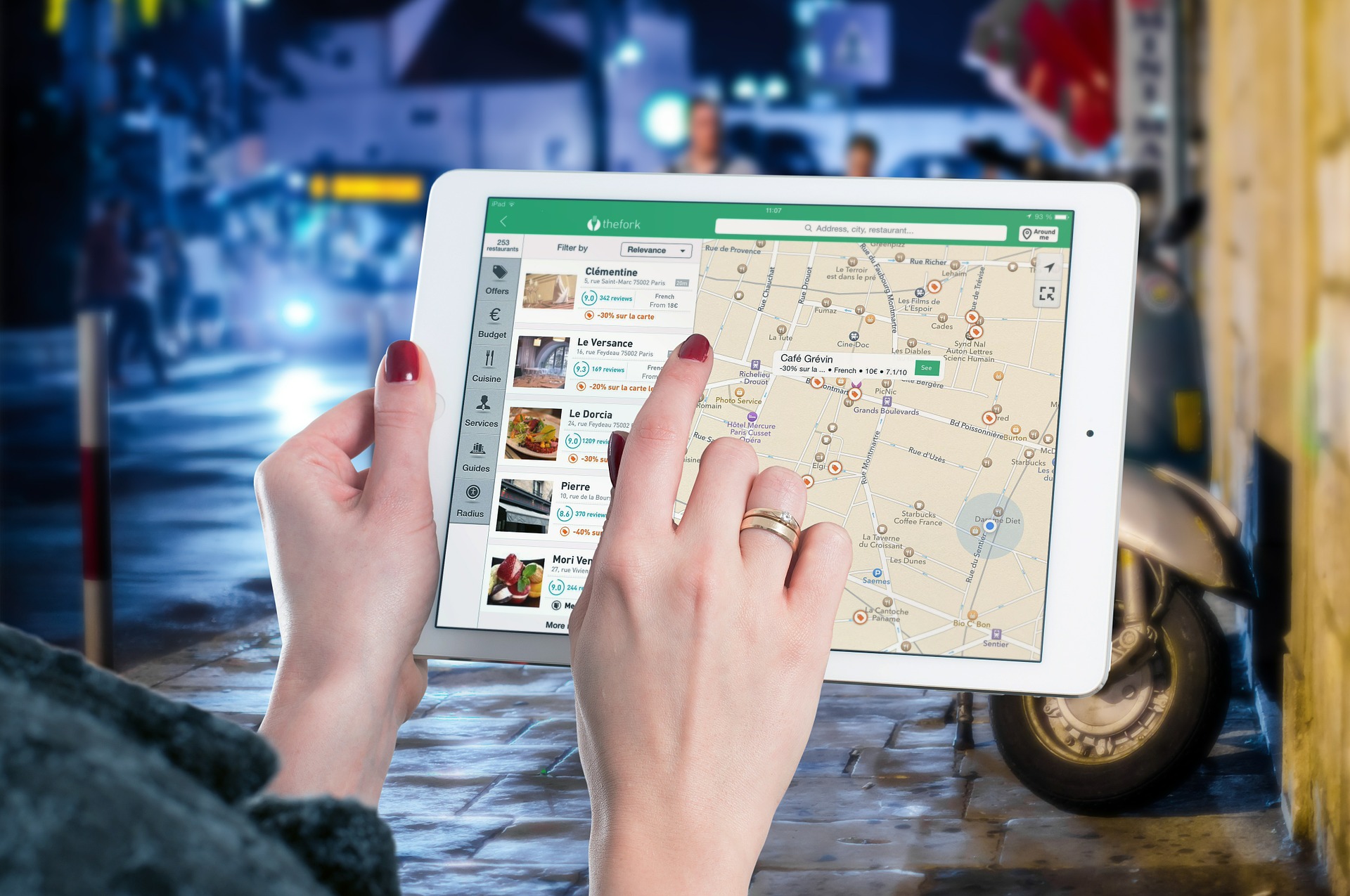 Whether it is strolling around a grocery store, a hospital, or a stadium, it can get annoying wandering around an unfamiliar location to look for something important. Lessen the customers or visitors hassle searching for a spot on a premise and start using a more convenient and faster way to guide them – the digital wayfinding map. Fuse the digital technology advancements and open communications through an interactive wayfinding design to exceed expectations.
Whether it is strolling around a grocery store, a hospital, or a stadium, it can get annoying wandering around an unfamiliar location to look for something important. Lessen the customers or visitors hassle searching for a spot on a premise and start using a more convenient and faster way to guide them – the digital wayfinding map. Fuse the digital technology advancements and open communications through an interactive wayfinding design to exceed expectations.
What is Digital Wayfinding?
Wayfinding is a process of navigating within a single location or between two separate sites, and the most advanced form of wayfinding is the digital form. Digital wayfinding uses electronically facilitated navigation through maps and digital routing, allowing directional assistance to guide users efficiently.
Digital wayfinding mapping utilizes interactive screens placed within buildings, mostly in the lobby, to provide directional information and directories to visitors. Unlike static maps and signs, digital wayfinding maps enable users to interact with a screen while providing information via a video representation. Here are the three types of digital wayfinding displays mostly used in digital wayfinding signage and maps.
Digital Static Wayfinding
The simplest form of this solution gives the visitors an easy point of reference through an electronic map as it shows them all the locations in an area using a simple graphic layout. It also allows a feature to display content highlighting upcoming events, marketing programs, and other recent incentives, maximizing more benefits. Although this form is the least expensive option among the three, it is not interactive or engaging for the customers or visitors.
Interactive Wayfinding
From its name, this solution is a more user-friendly method with its interactive features using fully personalized touch-screen technology. Thus, it can guide an individual through a facility by touching and typing the destination’s name. The guests don’t need to stand at a wayfinding unit as interactive wayfinding maps allow them to see the exact route in a precise and engaging way.
3D Wayfinding
The last method is the most advanced but also the most complicated among the three solutions. 3D wayfinding maps allow the visitors to visualize the location through a 3D map. It can dynamically guide the guests with enhanced functionality and realistic representation of an area. This solution is the resort of companies who want to impress their patrons, but it may take up several notches.
Features of Digital Wayfinding Software
The software running on digital wayfinding maps should be intuitive and adaptable, like the information it provides. Here are the seven essential software features of digital wayfinding.
1. Interactivity
Digital wayfinding software has front-end, experiential components for a more convenient and interactive user advantage. It includes point-to-point navigation, pop-up directory information, and interactive maps, allowing users to dictate their wayfinding experience.
2. Mobile Support
Aside from kiosks and screens in the lobby and other facilities, digital wayfinding also comes with mobile support via a downloadable app, QR codes, or kiosk-to-mobile SMS directions. Guests can now access wayfinding directions anywhere they go.
3. Web Support
Web access extends a wayfinding system’s reach beyond physical installations, offering online maps and directories. It is the best way to provide a facility map on a company’s site, enabling potential visitors to check out the area online.
4. Pushed Updates
The real convenience of a digital wayfinding system for the facilitators’ side is how easy it is to manage and update. Notified updates on wayfinding software make it easier to update navigation if employees change offices or the facilities grow and relocate, avoiding incorrect maps.
5. Dynamic Positioning
This feature is the key for the users to know where they are related to where they want to go, capturing the user’s real-time location and displaying it on the map.
6. Point-to-Point Directions
It simplifies complicated open directory’s struggles in getting from point A to point B. This feature can efficiently route based on a room, employee, or department in a less complicated process, along with dynamic positioning.
7. Back-End Functionality
This feature depends on the brand and customization of a digital wayfinding software, but having widespread integrations is a plus. Open API and automation capabilities are also some of the advanced functionalities that some software brands offer.
Benefits of Digital Wayfinding Maps
Often placed near the entrance and throughout buildings, digital wayfinding maps’ obvious benefit is to assist guests in finding their way. However, these aesthetically interactive maps do more, and here they are.
- Reduces Visitor Frustration and Improves Satisfaction: When guests can quickly and comfortably find what they are looking for, they become more satisfied as they don’t need to waste time or energy.
- Clears Congested Pathways: Guests who don’t know the way mostly gather and stop in walkways. Traffic can keep moving when visitors know their paths to their destination.
- Reinforces Branding: Aside from ease of access, digital screens also contribute to the branding as it features a company’s logo, colours, and graphics in front of guests that interact with the map, creating lasting brand recognition.
- Lessens Human Resource: Digital wayfinding maps allow organizations to rely less on human resources in guiding guests while providing customized information a visitor needs.
- Shows Technology Investment: Displaying interactive technology indicates that an organization commits itself to stay updated with the latest technology, making it a premium and high-end store or facility.
- Provides Supplemental Data: Information and content on the digital screen allow sharing and dissemination beyond directory and map details. It can be news, weather, and other updates featured on the digital wayfinding map.
- Allows Emergency Messages: As digital screens placed throughout the premises syncs with a unified source, wayfinding tools can also be a centralized communication that can quickly share emergency notices in an instant.
- Convenient Wayfinding Signage Updates: Static print maps need new versions during facility changes, but digital wayfinding allows quicker updates with little to no cost.
- Creates Income Opportunities: As digital maps allow supplemental information, promotion is also an advantage. This feature creates marketing opportunities from earning income from non-competing third-party ads.
Digital Wayfinding Tips and Advice
Like other technologies, digital wayfinding can also impose disadvantages when misused, especially in its visual design. Thus, here are some tips and advice when availing of digital wayfinding signage and maps.
- Make it clear by utilizing colour-coded designs.
- Use discernible paths and standardized icons while meeting ADA guidelines.
- Plan in detail and verify maps by walking in shoes.
- Provide context and identify hotspots.
- Offer SMS directions and QR codes.
- Let designers help.
A variety of industries benefit from the uses of digital wayfinding maps, including these business premises:
- Hospitals and medical facilities
- Airports
- Malls
- Resorts and hotels
- Arenas and stadiums
- Convention centres
- Educational campuses
- Residential complexes
Conclusion
Digital wayfinding mapping contributes in many aspects, but it requires crucial preparation as it is mainly about enhancing user experience. In developing wayfinding signage like digital maps, always try to see from the visitor’s perspective. Gather as much information as possible, ensuring that the facility and design collaborate towards the guests and customers’ utmost convenience.









